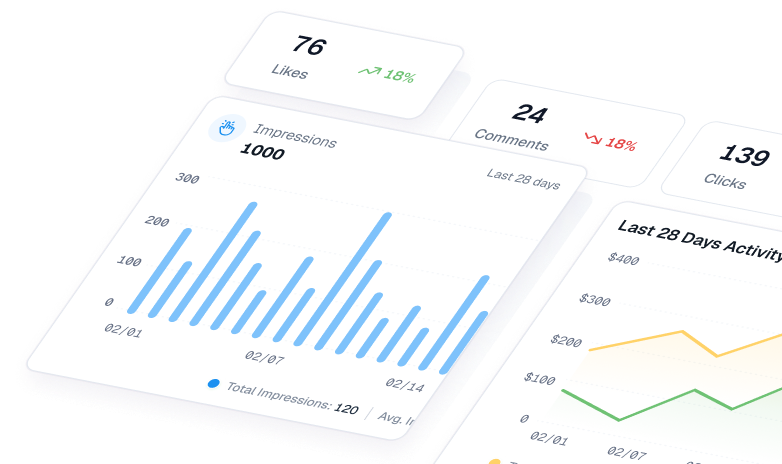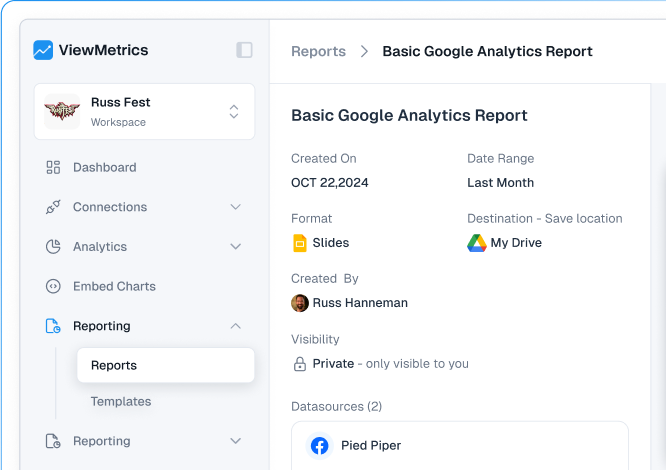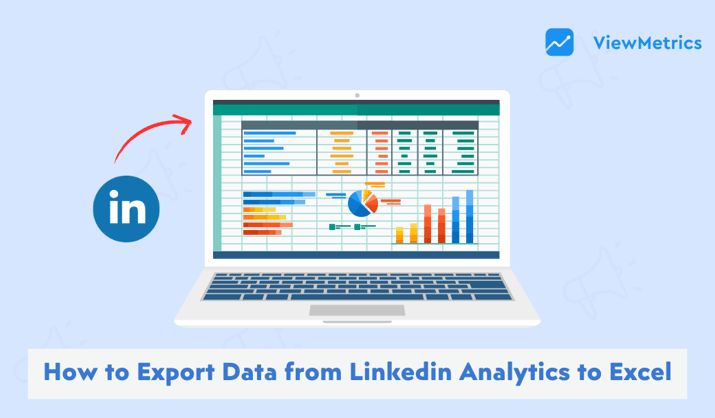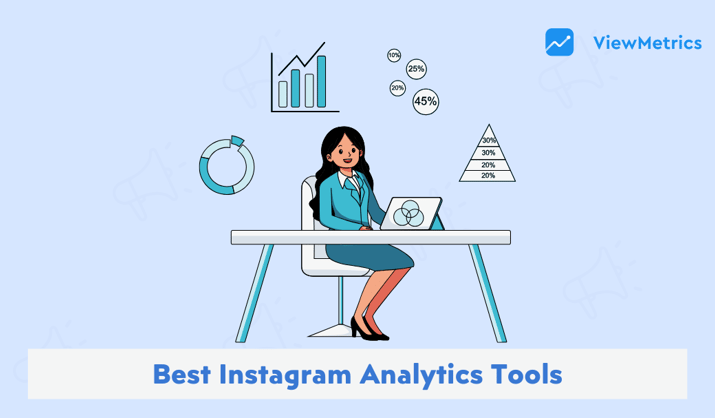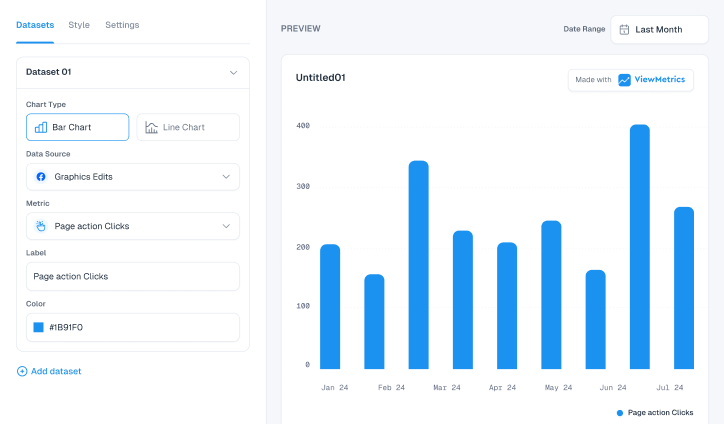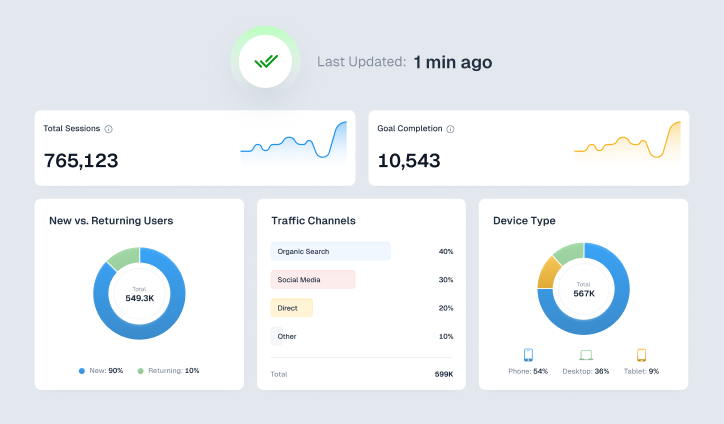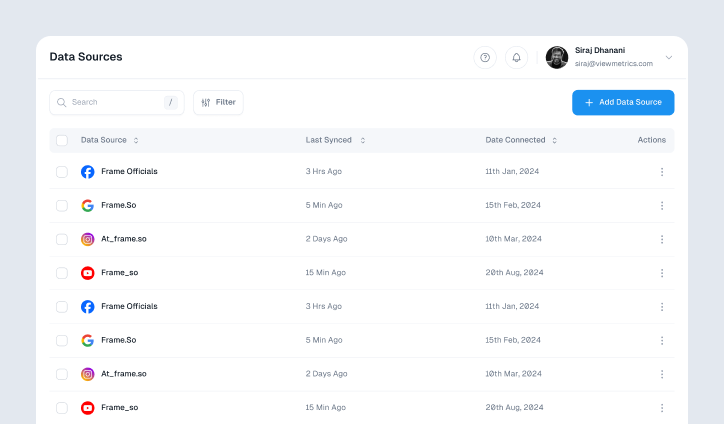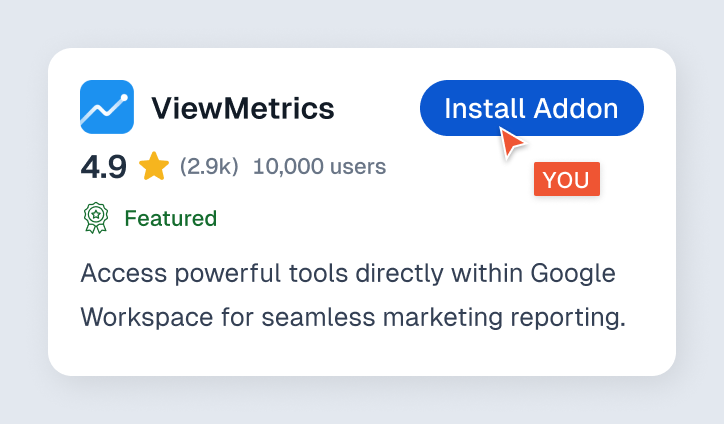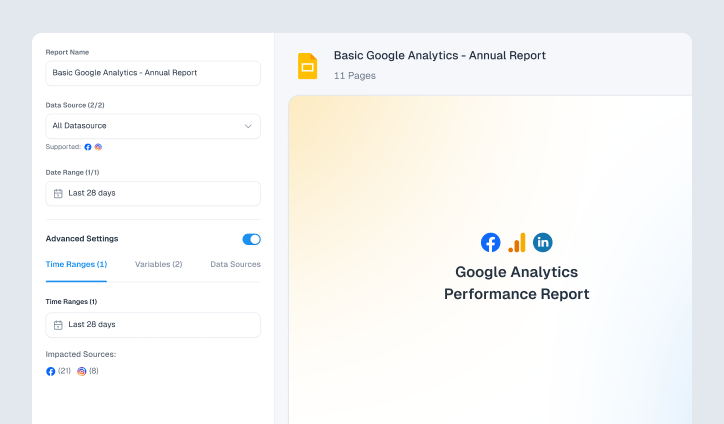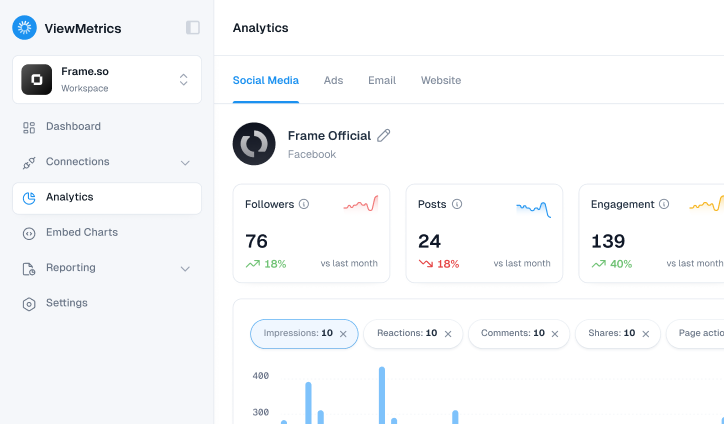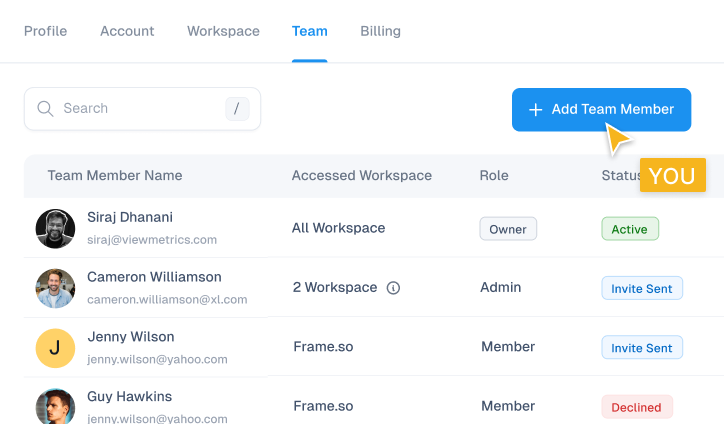Key Takeaways
- LinkedIn analytics tools help you track performance, refine strategy, and prove ROI.
- ViewMetrics stands out in 2026 with automated cross-channel reporting.
- Creators benefit most from tools like AuthoredUp and Taplio.
- Exporting data to Excel gives you more control for deeper reporting.
- Competitor-focused tools like RivalIQ and Social Insider keep you ahead of the game.
If you are active on LinkedIn in 2026, you already know the platform has become more than a networking site. It’s where professionals build personal brands, companies attract leads, and agencies show results to clients.
But here’s the truth: without the right LinkedIn analytics tools, you can only play guessing games instead of making informed decisions. The good news? You now have plenty of options. Some tools help you understand your audience better, others save time with automated reporting, and some even use AI to suggest what to post next.
In this article, you can discover the best LinkedIn analytics tools in 2025, how they compare, and which one might fit your needs.
Quick Comparison Table of Best LinkedIn Analytics Tools
| Tool | Pros | Cons | Best For |
| ViewMetrics | Multi-channel dashboard, automated LinkedIn reporting, easy template design, team roles | Limited advanced post/engagement analytics compared to LinkedIn-specific tools | Agencies, freelancers, small businesses needing visual, cross-channel reporting |
| AuthoredUp | Detailed post analytics, engagement tracking, post formatting tips | Only covers posts authored by a user, not company pages or competitors | Personal branding, content creators, individuals |
| Inlytics | Visual profile analytics, engagement metrics, scheduling features | Focuses on personal profiles, limited company insights, paid features needed for advanced metrics | Personal pages, individuals tracking profile growth |
| SocialPilot | Scheduling, multi-account management, competitive analytics, team collaboration | Limited in-depth post engagement analytics for LinkedIn | Agencies, SMBs managing multiple LinkedIn accounts |
| Taplio | AI-powered suggestions, influencer insights, post-performance tracking | Higher pricing, mainly focused on content creators | Personal branding, LinkedIn content optimization |
| SocialChamp | Automation, multi-network scheduling, basic reporting | Less advanced LinkedIn reporting | Small agencies, solo users, basic scheduling needs |
| Hootsuite | Robust scheduling, unified dashboard, team workflows | LinkedIn analytics less detailed, higher cost | Agencies, enterprises needing classic social media dashboards |
| Social Insider | Deep engagement stats, competitor benchmarking, niche insights | Advanced analytics locked in higher tiers, learning curve | Agencies, brands tracking competitors and advanced analytics |
| RivalIQ | Multi-channel comparison, customizable reports | Can be expensive, more benchmarking than engagement focus | Agencies doing competitive tracking |
| Brandwatch | Advanced analytics, sentiment analysis, enterprise integrations | Very high pricing, complex for small users | Large brands, agencies, enterprise-level monitoring |
10 Best Analytics Tools for LinkedIn in 2026
Here’s a detailed look at the most useful tools this year. Each one stands out for different reasons, so think about your goals as you go through them.
-
ViewMetrics

If reporting takes too much of your time and resources, ViewMetrics is one of the best free LinkedIn analytics tools for you, with some paid features. It pulls your LinkedIn and other marketing data into one clean dashboard.
Instead of copying numbers into spreadsheets, you get automated reports that you can share with clients or your team. You can even use pre-built templates, which saves a ton of time.
-
AuthoredUp

Ever post something and wonder why it didn’t perform well? AuthoredUp helps you figure it out. It’s built for people who write on LinkedIn often. So, if you are a coach, freelancer, or a thought leader, it is ideal for you. You get detailed insights into how your posts are doing and even suggestions on formatting so your content looks its best.
-
Inlytics

If you want to measure how your LinkedIn profile itself is performing, Inlytics gives you that bigger picture. It shows your growth over time, how people interact with your posts, and even offers scheduling features. It’s especially handy if you’re focusing on building your personal brand rather than managing a company page.
-
Social Pilot

Managing multiple LinkedIn accounts can be overwhelming. SocialPilot makes that easier with its scheduling, team collaboration features, and reporting. Agencies and small businesses use it because it balances ease of use with enough analytics to keep clients happy.
-
Taplio

Taplio brings AI into LinkedIn growth. It analyzes your posts, suggests improvements, and even helps you connect with influencers in your space. For creators and professionals who want to grow their audience quickly, Taplio is a powerful companion.
-
SocialChamp

If you are just starting or don’t need advanced reporting, SocialChamp is a simple option. This LinkedIn analytics tool lets you schedule posts across platforms and gives you basic reporting. It’s not as advanced as some others, but it’s affordable and easy to use.
-
Hootsuite

Hootsuite has been around for years and is still trusted by enterprises and agencies. It shines when you are managing multiple platforms at once. For LinkedIn it gives you scheduling, team workflows, and solid reporting.
-
Social Insider

Want to know how your LinkedIn strategy stacks up against competitors? Social Insider is perfect for that. It dives into detailed engagement metrics, helps you benchmark against others in your industry, and provides niche insights. It takes time to get comfortable with, but the data is worth it if you need competitive analysis.
-
RivalIQ

RivalIQ is built for comparisons. It helps you see where you stand against other brands by tracking engagement, posting frequency, and growth. Agencies love it because they can show clients exactly how they measure up against competitors.
-
Brandwatch

If you are a big brand with reputation to manage, Brandwatch is one of the most advanced tools out there. It combines social listening, sentiment analysis, and detailed analytics. It’s not built for individuals. But for larger companies, it offers deep insights that you can’t get from native LinkedIn analytics.
Step-By-Step Method for Exporting Data From LinkedIn Analytics to Excel
Exporting your LinkedIn Analytics data to Excel is easier than it sounds. Follow this step-by-step method to make the process quick and hassle-free.
- Go to your Page admin view.
- Click Analytics in the left menu.
- Choose from Content, Visitors, Followers, Leads, Search Appearances, Newsletters, or Competitors.
- Hit the Export button on the top right.
- Select your time frame and confirm export.
- Download your XLS file.
Need visuals? Here’s a step-by-step guide on how to export data from LinkedIn Analytics to Excel.
Why You Should Use LinkedIn Analytics Tools
LinkedIn’s built-in analytics give you a snapshot, but to really understand what’s working, you need the right LinkedIn analytics tool. It can help you achieve the following:
-
Get to Know Your Audience
Analytics tell you exactly who engages with your content. You can see details about industries, roles, and even job functions of your followers.
-
Improve Your Content Strategy
Once you know what performs well, you can post more of it. Analytics help you refine your content calendar.
-
Show ROI Clearly
Need to prove results? The best LinkedIn analytics tools enable you to present data-backed reports to clients, managers, or stakeholders.
-
Track Engagement Patterns
Instead of focusing only on likes, you can check deeper engagement patterns. Comments, shares, and click-throughs matter more in 2026.
-
Stay Ahead of Competitors
Competitor insights from tools like RivalIQ and Social Insider help you spot trends before others do.
Picking the right LinkedIn analytics tool depends on your goals. If you want automated, visual reports without the headache, ViewMetrics is an excellent choice. If you are focused on personal branding, AuthoredUp or Taplio can help you grow. And if competitor tracking is your priority, RivalIQ or Social Insider are worth the investment.
The bottom line: no matter which tool you choose, using analytics is no longer optional. It’s how you make better decisions, save time, and prove results.
Frequently Asked Questions
1. What is the purpose of LinkedIn Analytics?
LinkedIn analytics is used to monitor follower growth, analyze audience demographics, evaluate content performance, and learn more about page interaction. It’s also a crucial tool for evaluating the effectiveness of marketing campaigns and refining platform content strategies.
2. How does LinkedIn insights appear to me?
Log in to your LinkedIn account, go to your company page or personal profile, then select the Analytics tab to view your LinkedIn insights. Performance information regarding audience demographics, followers, and content can be viewed in this tab.
3. How can I examine my data on LinkedIn?
Either LinkedIn Analytics or a third-party application like ViewMetrics can be used to analyze your LinkedIn data. More sophisticated reporting capabilities, visualization choices, and the capacity to generate repetitive reports are all provided by these technologies.
4. Is it possible to export data from LinkedIn Analytics?
Indeed. Navigate to the admin view of your LinkedIn page, select Analytics from the menu on the left, and then pick the desired data category, such as Content, Visitors, or Followers. After that, select your timeframe, click the Export option in the upper right corner, and download the XLS file.
5. Which is the best free LinkedIn Analytics tool in 2026?
Although many products provide free versions, ViewMetrics stands out in 2026 because of its easy-to-use interface for both individual artists and agencies. It is one of the most popular free LinkedIn analytics tools because of its smooth interaction with Google Sheets and Slides and automated reporting options.
6. Is it possible to monitor the performance of specific posts on LinkedIn?
Indeed. You can monitor each post’s impressions, clicks, and engagement with Native LinkedIn Analytics. Deeper insights into audience response and post-by-post performance are provided by tools such as SocialPilot, AuthoredUp, and Taplio.
7. Is competitive benchmarking supported by LinkedIn analytics tools?
Of course. You may compare posting frequency, engagement rates, and audience growth with other companies in your industry by using competition analysis services offered by platforms like RivalIQ, Social Insider, and Brandwatch.


